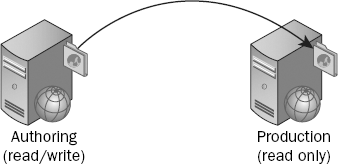17.1. Content Deployment Fundamentals
The examples in this chapter mimic a simple content deployment topology consisting of an authoring (read/write) environment and a production environment (read only). This topology is shown in Figure 17-1.
Figure 17-1. Figure 17-1

However, to keep the samples simple and easy to follow, only two site collections within two separate Web applications on a single server are used.
A core concept of content deployment is that it follows a "single master" model. Deployment is always one way from source to destination; it does not provide replication or synchronization capabilities. In essence, content deployment has three phases of operation:
Export content from the source — Based upon the configuration settings, content deployment exports content by packaging it up as cabinet (CAB) files on the source server.
Transport content from the source to destination — The CAB files are then transferred to the destination server.
Import content into the destination — The destination server opens the CAB files and imports the content.
In large or heavily used environments, it may not be desirable or acceptable for the content deployment import and export processing to take place on machines that are serving end users. This is especially true within the read-only, production farm and when deploying large amounts of content. For these scenarios, content deployment ...
Get Professional SharePoint® 2007 Web Content Management Development: Building Publishing Sites with Office SharePoint Server 2007 now with the O’Reilly learning platform.
O’Reilly members experience books, live events, courses curated by job role, and more from O’Reilly and nearly 200 top publishers.

